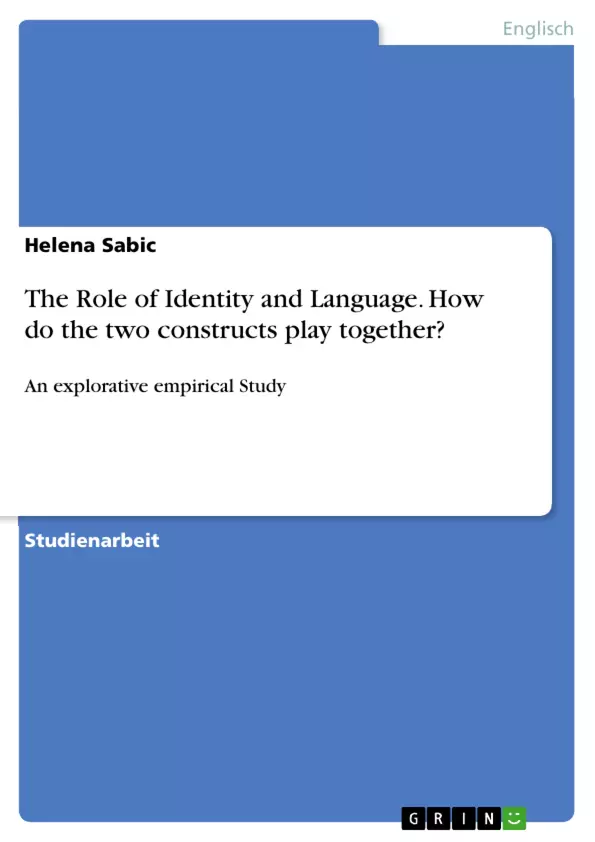Considering the fact that, according to the Enthologue catalogue, there exist 7097 known living languages, but only 196 countries in the world, it is intelligible to presume that people do generally speak more than one language (Lewis et.al., 2016, Chrystal, 2007). Literature often discusses the phenomenon of differences in individuals’ behaviour in native and foreign tongues. It is believed that our childhood languages vibrate with greater emotional intensity than do those learned in more academic settings, which is reflected in our thoughts and actions (Sedivy, 2016). Do the languages we speak shape the way we see the world, the way we think, and the way we live our lives. This paper aims to answer this question and how and if language and identity correlate by investigating the relationship with the help of a theoretical approaches as well as the practical implementation through a survey.
Inhaltsverzeichnis
- Definitions and Background Knowledge.
- Introduction..
- Identity
- Language.
- Monolingualism, Bilingualism and Multilingualism.……………………..
- The Survey
- Research Question...
- Hypotheses.....
- Experiment methodology.
- Design
- Recruitment.
- Participants.
- Analysis of results.
- Pearson Correlation ......
- T-test.
- Evaluation of the results.
- Limitation & Discussion
- Scientific and linguistic implications
- Conclusion...........
- References
- Selbstständigkeitserlärung...
- Appendices......
- Literature Review.
- Tables..
- List of Figures
- Coding key
Zielsetzung und Themenschwerpunkte
Diese Studie zielt darauf ab, die Frage zu beantworten, ob und wie Sprache und Identität miteinander zusammenhängen. Die Studie untersucht die Beziehung zwischen den beiden Konstrukten mithilfe theoretischer Ansätze sowie der praktischen Umsetzung durch eine Online-Umfrage.
- Die Beziehung zwischen Sprache und Identität
- Die Rolle der Sprache bei der Konstruktion von Identität
- Die Auswirkungen von Mehrsprachigkeit auf die Identität
- Der Einfluss der Muttersprache auf die Identität
- Die Bedeutung von Sprache für die soziale Integration
Zusammenfassung der Kapitel
Die Studie beginnt mit einer Definition der Begriffe Sprache und Identität und beleuchtet den Zusammenhang zwischen beiden. Es wird erläutert, wie Sprache und Identität miteinander verflochten sind und wie sie die Wahrnehmung der Welt, das Denken und den Lebensstil beeinflussen können. Die Studie untersucht die Bedeutung der Muttersprache für die Entwicklung der Identität und die Auswirkungen von Mehrsprachigkeit auf die Identität eines Individuums. Es werden verschiedene theoretische Ansätze vorgestellt, die den Zusammenhang zwischen Sprache und Identität erklären, und es wird auf die Forschungsergebnisse in Bezug auf die Auswirkungen von Sprache auf die kognitiven Fähigkeiten, die soziale Interaktion und die kulturelle Zugehörigkeit eingegangen.
Der zweite Teil der Studie befasst sich mit der Durchführung einer Online-Umfrage, bei der 118 Personen aus verschiedenen Ländern befragt wurden. Die Umfrage untersucht den Zusammenhang zwischen Sprache und Identität anhand von Fragen zu den Muttersprachen der Teilnehmer, den von ihnen gesprochenen Sprachen, ihrer kulturellen Zugehörigkeit und ihren Erfahrungen mit Sprache und Identität.
Die Ergebnisse der Umfrage werden analysiert und interpretiert. Die Studie zeigt, dass Sprache eine wichtige Rolle bei der Entwicklung und Ausgestaltung der Identität spielt. Es wird deutlich, dass die Muttersprache eine wichtige Quelle der Identitätsbildung ist, aber auch, dass Mehrsprachigkeit die Identität bereichern und zu einem Mehr an kultureller Kompetenz beitragen kann.
Schlüsselwörter
Die Schlüsselwörter der Studie sind: Identität, Sprache, Sprachkompetenz, Mehrsprachigkeit.
- Citar trabajo
- Helena Sabic (Autor), 2016, The Role of Identity and Language. How do the two constructs play together?, Múnich, GRIN Verlag, https://www.grin.com/document/355633



